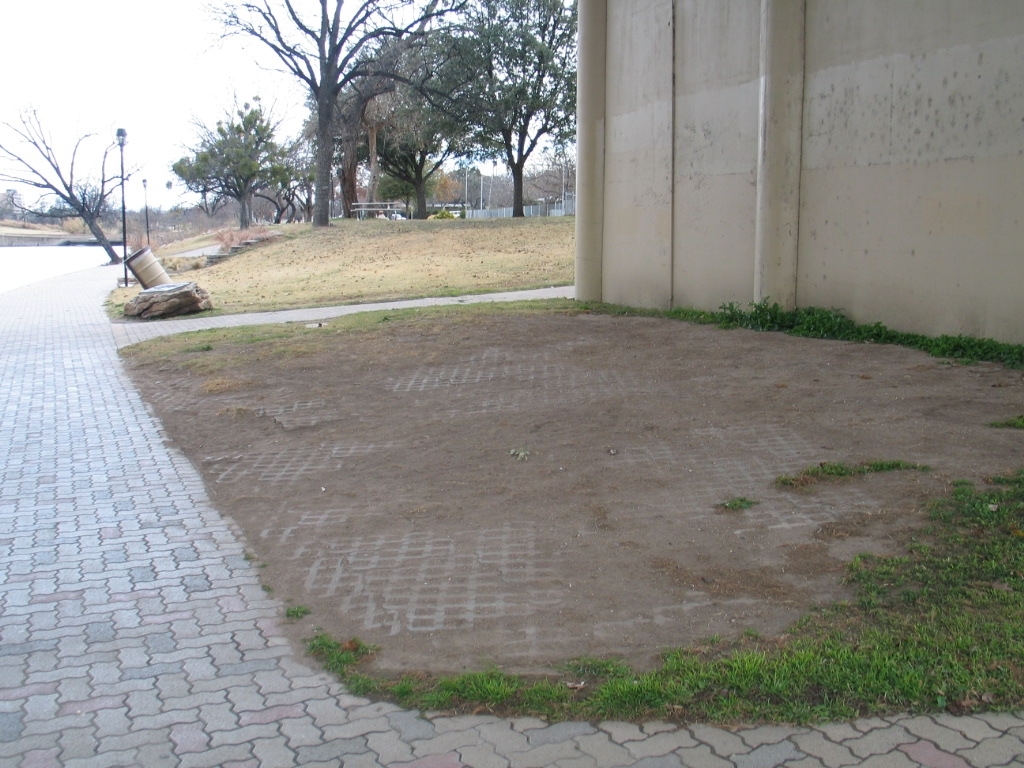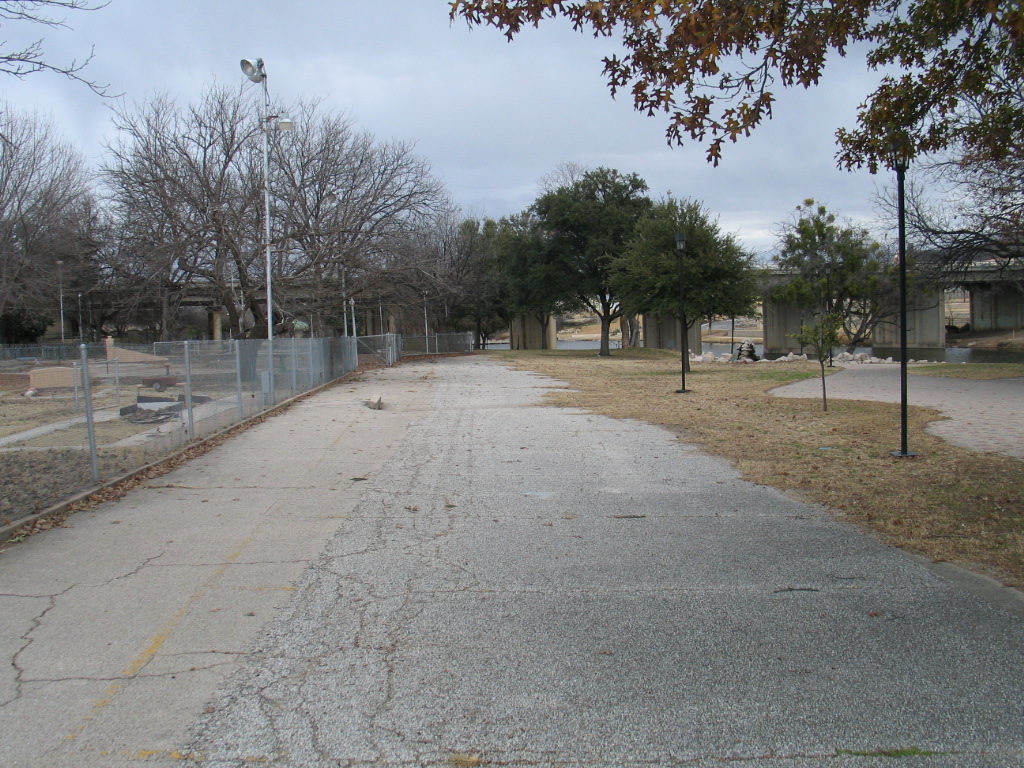Part I, History:
Our small city in West Texas has a river running through it. Yes, it’s a bit of an oxymoron.
San Angelo is at the confluence of three rivers--due to this, there is a lot of history and life involved. It was a Native American hub of activity as well as the location of a frontier fort. Because of the river, I believe our city is the envy of every other dusty city within 120 miles.
However, since the city's humble official beginnings as a western fort outpost called Fort Concho in the 1860's , the river has been neglected or worse. Early settlers treated it as a trash dump and sewage channel. Early buildings built along our main street ignored it, putting the backsides of buildings facing the river to allow for easier dumping of trash. There were a series of half-hearted attempts at "beautification" but not until the 1990's was there serious consideration of making the river a primary focus for the city. Still, the river was a slowly evolving project until 2006, when a half-cent sales tax was passed by voters to accelerate development.
EARLY VIEW OF FORT CONCHO WITH CONCHO RIVER IN FOREGROUND
EARLY MAP OF SAN ANGELO
Reflections on a River, Part II, The Commission:
There are a few architects in our small city but no landscape architects. So, when the Concho River Revitalization project was approved by voters to proceed, the City looked outside of San Angelo to a very large A/E landscape firm for services. However, the marriage between the City and the A/E firm wasn’t a productive one, and the City quickly tired of the designs presented, labeling them as "cookie cutter." They hired Kinney Franke Architects in their place. The work included extensive permitting through Federal agencies, bank stabilization, water quality issues, dredging, trails, plazas, lighting, fountains, etc. The hope was to revitalize and reinvent a key stretch of the river as it flowed through downtown, over a mile long.
There was a learning curve. Though we had completed parks before, a landscape project of this scale and scope was daunting. We immersed ourselves in landscapes: relearning landscape history, visiting other river cities such as Austin, San Antonio, and New Orleans, visiting a Landscape Architect friend in Midland, reading books, meeting with the Upper Colorado River Authority folks, etc.
EXISTING PLAZA
Reflections on a River, Part III, Thoughts:
With this crash-course underpinning (and having walked and biked our river trail for many years), we proceeded to learn and create. Now, with the project built and embraced by the city, here are some reflections on the work:
1. The project was a success because the work grew out of collaboration. Citizens, City Staff, City Council, consultants, each individual in our office, contractors, stone masons, UCRA staff, and other subs all provided valuable input that we tried to heed. Perhaps because we didn't know a great deal about landscape architecture at the beginning, we were able to listen more closely and follow good ideas no matter where they originated. Many participated and have now taken ownership. A good thing.
2. Practicing good urban design was crucial: Tying seamlessly into the existing fabric of City (streets, sidewalks, landscaping, plazas, etc.), using sequential vision to create a sense of discovery, accentuating landmarks, and focusing and fostering activity zones were all key in creating a larger coherent fabric, with each individual element adding to the whole.
3. There was a lot to work with on an already beautiful river, even though much of what was built was tired...very tired. By building on these existing qualities and buildings, by "going with the givens," it allowed us to cost-effectively enhance the character of distinct areas. For example:
- The "wasteland" areas below bridges were eroded and full of trash. Yet, there was abundant shade and the temperature was noticeably cooler than adjacent sun-filled areas. And so, we developed these shade zones as areas to put seating, exercise areas, artwork, etc. They have become very popular on hot West Texas afternoons.
- The river had areas with distinct characteristics. And so, we were able to enhance these characteristics and create certain zones along a river trail: a Nature Zone, shade/shadow zones, a Cultural Zone, a Kid Play zone, and other future development zones, like pearls on a long necklace. We simply built on what was already emerging. I believe this is what Christopher Alexander calls "listening to a place."
THE BOSQUE
COMPLETED PLAZA NEXT TO 87S BRIDGE - AT NIGHT
Reflections on a River, Part IV, More Thoughts:
1. We discovered that Landscape Architecture is not all that different from the architecture of buildings and places. Good design seems to be a universal--whether it be buildings, landscapes, objects, or places--that can unlock potential. This sounds very heady but during the design for the river, we became much more aware of simple elements such as plant types, xeriscaping, water use in a desert environment, hot/cool, shade/shadow/light, moving thru spaces, natural materials: we tried to use these as tools to create a sense of place...and sometimes of wonder, which seems to be at the heart of good landscape design. Used well, these elements make a place where folks want to bring kids. We are particularly fond of the large slab stones that were brought in to create a substantial and low maintenance pattern throughout the project.
2. I'm glad the City insisted on longevity and low maintenance. Too often architects design things that are beautiful...for a year or two. And then the earth starts to reclaim what it lost, the beauty gets swallowed by time, and maintenance issues increase. In light of this, everything we specified or designed was for the long term. For example the LED lighting along the trails rarely needs maintenance, requires less energy, and lasts ten years or more.
COMPLETED LIGHT TOWERS AT THE BOSQUE
LED BRIDGE UPLIGHTING AT NIGHT
Reflections on a River, Part V, Even More Thoughts:
1. We learned a lot about water quality from the Upper Colorado River Authority. We visited the state of the art LCRA facility in Austin and traced where stormwater from the streets begins as black sludge and, after passing through several passive BMP's or filters, the water is purified and cleaned until it is clear as crystal. We tried to adopt as many of these Best Management Practices as possible so that our river can begin to recover from years of neglect. What is on the ground ends up in the river and the muck on the streets steals the oxygen from river water. So we tried to slow stormwater down to prevent erosion and we filtered it slowly through open fields or Aqua Swirl tanks or bermed detention ponds so that it would lose impurities as it made its way to the river. We studied ways to stabilize eroding riverbanks, arriving at rip rap as our best alternative due to costs and zero maintenance but also because rip rap boulders slow water down and creates habitat for aquatic life.
2. There is a thriving art community in San Angelo. Artists came forward to propose different art pieces for identified areas. A sculptor was commissioned to create limestone panels of scenes depicting local flora and fauna. Sixteen of these panels were set into a series of stone column markers with uplit light cubes at the tops. A series of mosaic pieces were installed in shaded areas below bridges: mosaic cars/trucks and a fantastic fifteen foot by thirty foot large mural. Overall, thirty new pieces were added to create a remarkable string of artwork along the trail.
When I first arrived in San Angelo twenty eight years ago, I remember jogging a broken pathway along the Concho River, amazed at the beauty and potential. I remember seeing heron nests in trees and ducks landing on water. Through the years, before the river project began, I biked often and slowly along the banks, getting a sense of the place, learning the history, patterns, the natural trails of wildlife, the smells, the hot/cool areas, shade/shadow/light at different times of the year, never imagining that we would be a part of revitalizing the heart of a fine city. You never know. I'm very thankful that our firm has had the opportunity to work on a project that brings such life. We were pleased that the project won the statewide award from the Texas Recreation and Parks Society for Best Park of 2014.
FILTERING POND / FOUNTAIN
MOSAIC MURAL ALONG RIVER TRAIL









